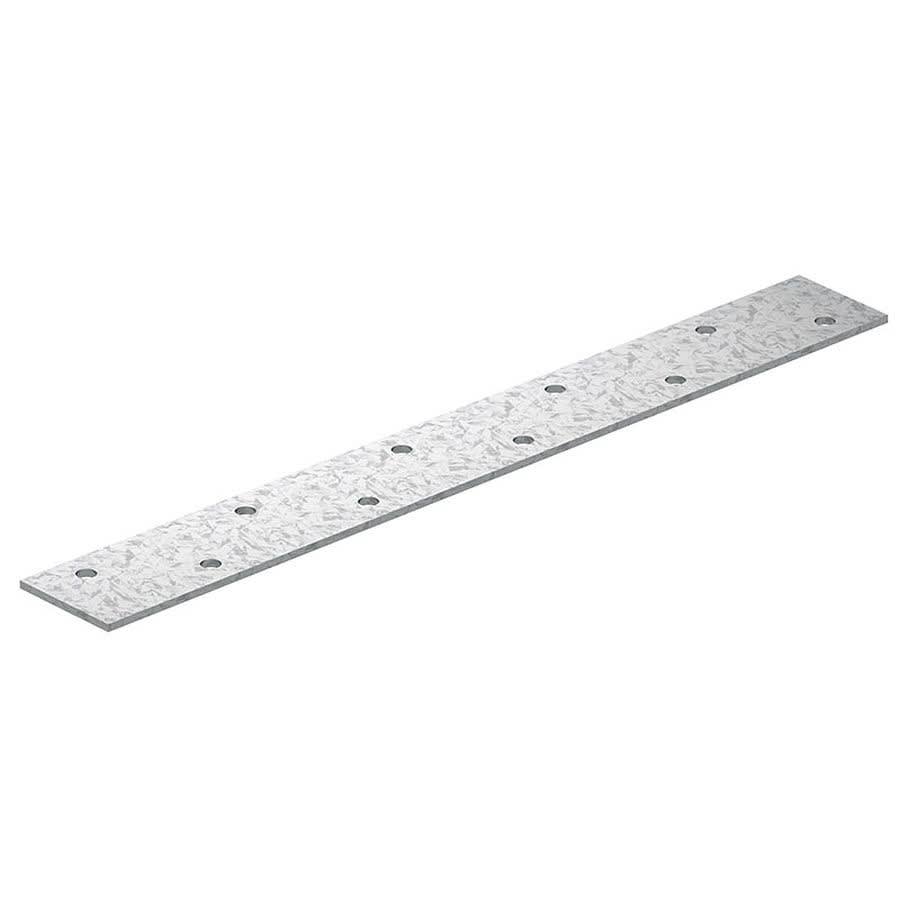Restraint Straps
(27 Products)Restraint straps provide essential structural reinforcement between masonry, timber, and roof elements, ensuring compliance with lateral restraint requirements in domestic and commercial building construction. We supply light and heavy-duty flat, bent, and twisted variants designed to deliver secure, load-bearing connections across wall plates, joists, and rafters.
Understanding Restraint Straps
Restraint straps are tension components used to tie timber floor and roof structures to masonry walls, preventing lateral movement and structural separation under load or wind uplift.
Manufactured from galvanised steel, typically conforming to BS EN 10346 standards for zinc-coated finishes, these straps deliver high corrosion resistance and long-term durability in both internal and external environments.
Available in light duty and heavy duty configurations, restraint straps are selected according to structural loading and installation requirements. Light duty types suit horizontal restraint to wall plates and joists in standard dwellings, while heavy duty straps provide enhanced strength for vertical restraint and applications subject to higher stress or uplift.
Common designs include flat, bent (with standard 100mm or 150mm bends), and twisted patterns to accommodate variations in joist or rafter positioning relative to supporting walls.
Lengths typically range from 300mm to 1500mm, allowing for correct embedment and fixing spacing as per current building regulations. Pre-punched holes simplify installation, ensuring reliable fixing to timber and masonry using compatible screws or bolts.
Restraint straps form an integral part of overall structural stability systems within housing, extensions, roof trusses, and floor assemblies.
Material Range
- Light Duty Restraint Straps: Galvanised steel straps designed for horizontal restraint of wall plates, ceiling joists, and similar timber members under moderate loading conditions.
- Heavy Duty Restraint Straps: Thicker galvanised steel sections providing vertical restraint and greater tensile strength for use in roof, gable, and wall connections subject to higher wind or structural forces.
- Flat Restraint Straps: Continuous flat profiles used where direct alignment between connecting elements is maintained.
- Bend Restraint Straps: Pre-formed bends at 100mm or 150mm to allow return into masonry or offset from joists and rafters.
- Twist Restraint Straps: Twisted at 100mm to align with perpendicular fixing faces or non-parallel timber layouts.
Key Features
- Material: Galvanised steel to BS EN 10346 with corrosion-resistant zinc coating.
- Performance: Designed to meet building regulation requirements for lateral restraint to walls, floors, and roofs.
- Configuration: Available in flat, bent, and twisted profiles for adaptable fixing geometry.
- Lengths: Manufactured in standard sizes from 300mm to 1500mm for varied applications.
- Durability: Long service life with resistance to corrosion and environmental exposure.
- Installation: Pre-punched for easy fixing with compatible screws or bolts.
- Compliance: Suitable for use in accordance with BS 5268 and current Building Regulation Approved Document A guidance.
Typical Applications
- Wall and Floor Junctions: Providing horizontal restraint between joists and supporting walls.
- Roof Plate Connections: Securing roof timbers to masonry to resist uplift and lateral movement.
- Gable and Party Walls: Maintaining structural integrity against wind and racking forces.
- Timber Frame Construction: Assisting in tie-down and load transfer between timber and masonry interfaces.
Specification & Standards
- BS EN 10346: Defines galvanised steel coating requirements ensuring corrosion protection.
- BS 5268-3: Guidance on structural use of timber, including restraint strap applications.
- Building Regulations Approved Document A: Outlines lateral restraint requirements for wall, floor, and roof assemblies.
- Material Thickness: Typically 2.5mm for heavy duty and 1.5mm for light duty types, depending on manufacturer specification.
Related Materials and Construction Uses
Restraint straps are used alongside wall plates, joist hangers, angle brackets, timber connectors, and fixing bolts within timber and masonry assemblies. They integrate with cavity wall construction, trussed rafter systems, and floor joist layouts, forming part of a comprehensive restraint and stability framework within modern structural design.
Their use complements other galvanised steel components such as wall ties, hold-down straps, and frame anchors to ensure full compliance with structural and safety standards.
Frequently Asked Restraint Straps Questions
What Are Restraint Straps Used For?
Restraint straps are used to provide structural stability by tying timber roofs, floors, and walls to masonry walls, preventing uplift and lateral movement in accordance with Building Regulations Approved Document A.
What Is The Difference Between Heavy Duty And Light Duty Restraint Straps?
Heavy-duty straps are typically 30mm x 5mm for main structural connections, while light-duty straps are 30mm x 2.5mm for lighter applications such as holding down ceiling joists or non-loadbearing elements.
What Standards Do Restraint Straps Comply With?
Restraint straps should comply with BS EN 845-1 for metal wall ties, straps, and fixings, and be manufactured from galvanised steel to BS EN 10346:2009 with a zinc coating of at least 275g/m².
When Should Flat, Bent, Or Twisted Restraint Straps Be Used?
Flat straps are used when fixing along a horizontal plane; bent straps accommodate changes in level; twisted straps align with timber joists or trusses at 90° to the wall face.
How Should Restraint Straps Be Fixed?
Straps should be fixed using minimum 50mm x 4mm corrosion-protected screws or 8mm bolts into at least three solid timber members, with fixings distributed evenly along the length as per structural design guidance.
What Lengths Are Restraint Straps Available In?
Typical lengths include 300mm, 600mm, 800mm, 1000mm, 1200mm, and 1500mm, allowing flexibility for varying structural requirements and to ensure adequate embedment into masonry or timber.
Can Restraint Straps Be Used In External Or Damp Environments?
Yes. For external or exposed environments, straps should be hot-dip galvanized or stainless steel to resist corrosion, in line with exposure conditions defined in BS EN 1995-1-1 and BS EN 335.
Are Restraint Straps Suitable For Timber Frame Construction?
Yes. Restraint straps are suitable for timber frame structures when designed to transfer wind and uplift forces from floors and roofs to loadbearing walls, ensuring lateral stability.
How Should Restraint Straps Be Installed To Meet Building Regulations?
Installation should follow Building Regulations Approved Document A and manufacturer guidance, ensuring correct orientation, embedment, and fixings to achieve the required restraint capacity.


